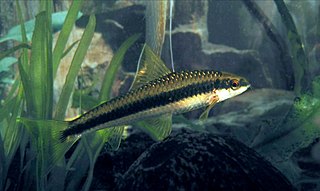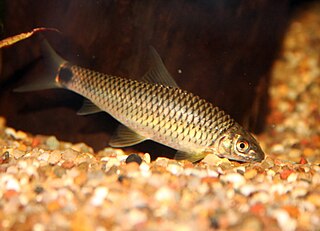
Rasbora is a genus of fish in the family Cyprinidae. They are native to freshwater habitats in South and Southeast Asia, as well as southeast China. A single species, R. gerlachi, is only known from an old specimen that reputedly originated from Africa (Cameroon), but this locality is considered doubtful. They are small, up to 17 cm (6.7 in) long, although most species do not surpass 10 cm (4 in) and many have a dark horizontal stripe.

Clarias is a genus of catfishes of the family Clariidae, the airbreathing catfishes. The name is derived from the Greek chlaros, which means lively, in reference to the ability of the fish to live for a long time out of water.

The Siamese algae-eater is a species of freshwater fish in the carp family, Cyprinidae. This bottom-dwelling tropical fish is found in mainland Southeast Asia, including the Chao Phraya and Mekong basins as well as the Malay Peninsula. Its natural habitats are streams and rivers as well as flooded forests during the rainy season. The Siamese algae-eater should not be confused with the flying fox or the false siamensis , lacking the distinctive black bands of the former.
Crossocheilus klatti, also known as the Isparta minnow or Anatolian golden barb, is a species of ray-finned fish in the genus Crossocheilus. It is found in the Lake Işıklı basin in the Büyük Menderes drainage in Turkey. There is some confusion regarding the identity of this fish. This poorly known species is closely related to Garra kemali, and likely should be placed in that genus.
Tylognathus is an invalid genus of ray-finned fishes in the family Cyprinidae. It was established by Heckel in 1843 without a type species. Varicorhinus diplostomus, described by Heckel in 1838 and erroneously redescribed by the same author in 1844 as T. valenciennesii, was later designated the type species. Today this fish is placed in the genus Bangana.

The spotted giant flying squirrel, also known as the lesser giant flying squirrel, is a species of rodent in the family Sciuridae. It is found in hill and mountain forests at altitudes of 200–4,000 m (660–13,120 ft) in Southeast Asia north to central China and the east Himalayan region, although the northern populations sometimes are regarded as separate species as the grey-headed giant flying squirrel, Chindwin giant flying squirrel and P. marica. Two of these, as well as a few other populations, lack the white spots on the upperparts for which it is named. Although a large flying squirrel, it is a relatively small giant flying squirrel.

The flying fox is a Southeast Asian species of freshwater fish in the family Cyprinidae. It is commonly kept in the aquarium trade. Among other foods, it is known to eat green algae. It is sometimes mistakenly referred to as the Siamese algae eater.

Labeoninae is a doubtfully distinct subfamily of ray-finned fishes in the family Cyprinidae of order Cypriniformes. They inhabit fresh water and the largest species richness is in the region around southern China, but there are also species elsewhere in Asia, and some members of Garra and Labeo are from Africa. They are a generally very apomorphic group, perhaps the most "advanced" of the Cyprinidae. A common name for these fishes is labeonins or labeoins.

The twospot rasbora is a species of ray-finned fish in the genus Rasbora native to south east asia. It is one of the members of the Sumatrana group.

Gyrinocheilus aymonieri is a freshwater fish native to large parts of Southeast Asia. It is of interest as a local food source and for the aquarium trade. Its common names include honey sucker, sucking loach and Chinese algae eater.

The leaping bonito is a species of saltwater finfish from the Scombridae (Mackerel) family. Scombridae includes such tribes as the mackerels, tunas, and bonitos – of the latter of which, the Sardini tribe, this fish is a member. It is the only member of the genus Cybiosarda, which is therefore called a monotypic taxon. Since the bonitos and tunas are close relatives, this fish has variously been referred to by such other common names as Australian tuna, striped bonito, and Watson's bonito.

Crossocheilus, also known as the fringe barbs, flying foxes, or "algae eaters", is a genus of fish in the family Cyprinidae. It is distributed in China, India, Indonesia, Malaysia and Thailand in Asia. These fish occur in several types of habitat, often fast-flowing rivers with rocky bottoms.

Gyrinocheilus is the single genus in the family Gyrinocheilidae, a family of small Southeast Asian cypriniform fishes that live in fast-flowing freshwater mountain streams. The species in this genus are commonly called "algae eaters". They hold on to fixed objects using a sucker-like mouth, and, despite the name, feed on a wide range of detritus, rather than simply on algae. A "golden" variety of G. aymonieri, the Chinese algae eater or "sucking loach", can be found in many pet shops and fish farms.
Crossocheilus periyarensis is a species of fish in the family Cyprinidae. This species is only found in Periyar River in Kerala, India.

Crossocheilus reticulatus is a freshwater fish in the family Cyprinidae from Southeast Asia. It grows to 17 cm (6.7 in) standard length.
Crossocheilus obscurus is a species cyprinid fish. It occurs on Sumatra (Indonesia) and in Peninsular Malaysia. It lives in fast flowing steams with rocky substrate.

Crossocheilus langei, also known as the red algae eater, is a species of ray-finned fish in the genus Crossocheilus. It is native to Malaysia and Sumatra. This bottom-dwelling tropical fish is found in mainland Southeast Asia. Its natural habitats are streams and rivers as well as flooded forests during the rainy season. It is often confused with the Crossocheilus oblongus, however, both are algae eaters and will behave similarly.
Crossocheilus nigriloba is a species of ray-finned fish in the genus Crossocheilus. It is native to eastern Borneo.
The Antakya minnow is a species of ray-finned fish in the genus Crossocheilus. There is some confusion regarding the identity of this fish. Fishbase identifies the species as extinct, formerly occupying the Orontes watershed in Turkey, however a synonym, Hemigrammocapoeta caudomaculata is identified as least concern by the IUCN, and is found in the Asi drainage in Turkey and Syria and Nahr al-Kabir at the border between Syria and Lebanon, and called the Asi golden barb. They may be distinct species.
Crossocheilus latius, also known as the smallmouth fringe barb, is a species of ray-finned fish in the genus Crossocheilus. It is endemic to the Kapuas basin, West Kalimantan on Borneo.











